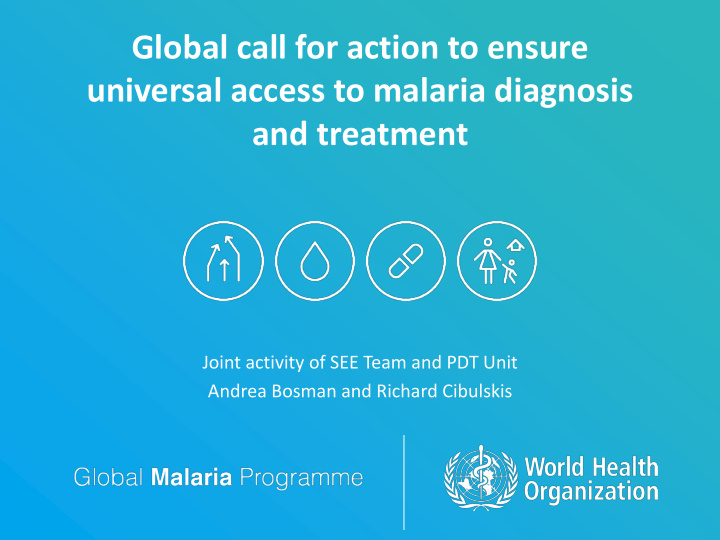



Global call for action to ensure universal access to malaria diagnosis and treatment Joint activity of SEE Team and PDT Unit Andrea Bosman and Richard Cibulskis
Outline of the presentation • Background • Objectives • Workflow • Timelines
Problem statement • There has been great progress in extending the coverage of malaria diagnostic testing and treatment (with appropriate antimalarial medicines) between 2000 and 2015. • Data are limited but and current evidence suggest that large gaps in programme coverage remain. • A better understanding of • who is affected by these gaps, • why these gaps occur, and • what strategies can be used to overcome them • … will help ensure universal access to care and enable the targets outlined in the Global technical strategy for malaria, 2016-2030 to be attained.
Objectives 1. To characterize the access to and utilization of malaria diagnostic testing and treatment services at country level: • to identify particular population subgroups or risk factors associated with the gaps and the role played by the different delivery channels used to provide services (i.e. public sector, private sector, community- based programmes); • Identify bottlenecks in service provision (e.g. knowledge, cultural barriers, geographical access, supply chain, financing, regulation, global supply etc); 2. To identify effective strategies (and successful examples) to increase access to, and utilization of, diagnostic testing and treatment services and elaborate a global response plan. 3. To identify data gaps and provide recommendations for strengthening monitoring of malaria testing and treatment.
Planned work – Phase 1 Preparatory work – background paper 1 to cover: 1. Policy and regulation • Registration and scheduling of malaria medicines and diagnostics • Regulations for providers: private sector and community level • Legal and social barriers for populations: migrants, ethnic minorities • Financial protection/ exemptions (children under five and pregnant women) • Taxes and tariffs for malaria commodities 2. Commodity delivery systems • Supply systems – quantification, procurement, distribution (including pull and push systems) • Support systems – workforce, information systems (need to consider organization of services e.g. decentralization).
Planned work – Phase 1 Preparatory work – background paper 2 to cover: 1. Funding: • Sources of revenue and payment: domestic taxation, international funding, insurance (private, social, community), out of pocket spending • Spending on health service delivery and commodity procurement and distribution • Financial management
Planned work – Phase 1 Preparatory work – background paper 3 to cover: 1. Need for testing and treatment - number of cases and population groups affected (age/ sex, urban/ rural, socio-economic status etc) 2. Demand for testing and treatment - where people from different groups seek treatment 3. Supply of diagnostic testing and treatment services - including community services and referral systems, provided by different delivery channels Tanahashi’s effective coverage model to identify gaps in coverage and 4. potential actions. Also explore the fraction of potential health gain delivered Information sources: • Household survey data • Health facility survey data • Routinely reported data • Supply of commodities • Health infrastructure • Qualitative data
Planned work – Phase 2 WHO Technical Consultation on access to malaria diagnostic testing and treatment Participants: • Representatives of relevant MOH programs (malaria, community services, surveillance and central medical stores) from multiple malaria endemic countries from all WHO Regions. • Representatives of technical and funding agencies and NGOs working with MOH programs on improving access and reporting on malaria diagnostic and treatment services, including in the private sector. Method of work: • Analysis of current situation based on three working papers, with the objective of completing a landscape analysis (Day 1) • Working groups on effective strategies to increase access to malaria diagnostic testing and treatment, reflecting different regional/health system context (Day 2) • Presentation, discussion and consolidation of the main components of a call to action to increase access to malaria diagnostic testing and treatment ( Day 3)
Planned work – Phase 3 Production of end products: • WHO global strategy to ensure universal access to malaria diagnosis and treatment • Technical report on gaps in diagnostic testing and treatment • Recommendations for strengthening monitoring of malaria testing and treatment
Proposed timelines • Preparation of pre-reads: March – October 2017 • Review of background papers by MPAC: October 2017 • Technical consultation: November 2017 • Initial draft call to action: February 2018 • Review & endorsement by MPAC (remotely): March 2018 • Launch of technical report and global call for action: World Malaria Day, 25 April 2018 • Launch and dissemination to WHO Member States and Main Funding Agencies: May – July 2018
Discussion
Recommend
More recommend